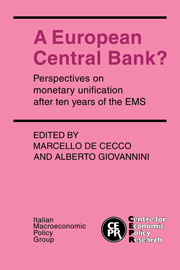Book contents
- Frontmatter
- Contents
- List of figures
- List of tables
- Preface
- List of conference participants
- 1 Does Europe need its own central bank?
- 2 Monetary policy, capital controls and seigniorage in an open economy
- 3 Seigniorage in Europe
- 4 Factor mobility, uncertainty and exchange rate regimes
- 5 Management of a common currency
- 6 The tastes of European central bankers
- 7 The costs and benefits of a European currency
- 8 The monetary unification process in nineteenth-century Germany: relevance and lessons for Europe today
- 9 The establishment of a central bank: Italy in the nineteenth century
- 10 The founding of the Fed and the destabilization of the post-1914 US economy
- 11 Panel discussion on the prospects for a European Central Bank
- Index
10 - The founding of the Fed and the destabilization of the post-1914 US economy
Published online by Cambridge University Press: 05 February 2012
- Frontmatter
- Contents
- List of figures
- List of tables
- Preface
- List of conference participants
- 1 Does Europe need its own central bank?
- 2 Monetary policy, capital controls and seigniorage in an open economy
- 3 Seigniorage in Europe
- 4 Factor mobility, uncertainty and exchange rate regimes
- 5 Management of a common currency
- 6 The tastes of European central bankers
- 7 The costs and benefits of a European currency
- 8 The monetary unification process in nineteenth-century Germany: relevance and lessons for Europe today
- 9 The establishment of a central bank: Italy in the nineteenth century
- 10 The founding of the Fed and the destabilization of the post-1914 US economy
- 11 Panel discussion on the prospects for a European Central Bank
- Index
Summary
Introduction
A standard assumption in the literature on optimal monetary policy is that the proper goal of policy is the reduction of the variation in output around its natural rate level (e.g., Friedman, 1953; Brainard, 1967; Fischer, 1977; Taylor, 1980). Indeed, one of the apparent triumphs of Keynesian economics is the fact that fluctuations in real activity have been smaller since World War II than they were prior to 1930 (e.g. Burns, 1960; Modigliani, 1977; Mayer, 1978). Although recent research by Romer (1986a, 1986b) suggests that the degree of stabilization is smaller than previously believed, there is still widespread agreement that such a stabilization would be desirable if it could be achieved.
The stabilization of output has not always been accepted as the primary goal of policy, however. This paper argues that neither the founders of the Fed nor the central bankers in charge during the first twenty-five years of the Fed's existence viewed the elimination of short-term movements in output as an important objective for policy. Instead, the framers of the Federal Reserve System and the early practitioners of central banking in the United States apparently thought that ‘stabilization’ of asset markets was the crucial task for the monetary authority (along with maintenance of the gold standard). Of course, the policy makers of that period presumably believed that calming financial markets led, in some longerterm sense, to better performance of the economy.
- Type
- Chapter
- Information
- A European Central Bank?Perspectives on Monetary Unification after Ten Years of the EMS, pp. 290 - 336Publisher: Cambridge University PressPrint publication year: 1989
- 5
- Cited by

